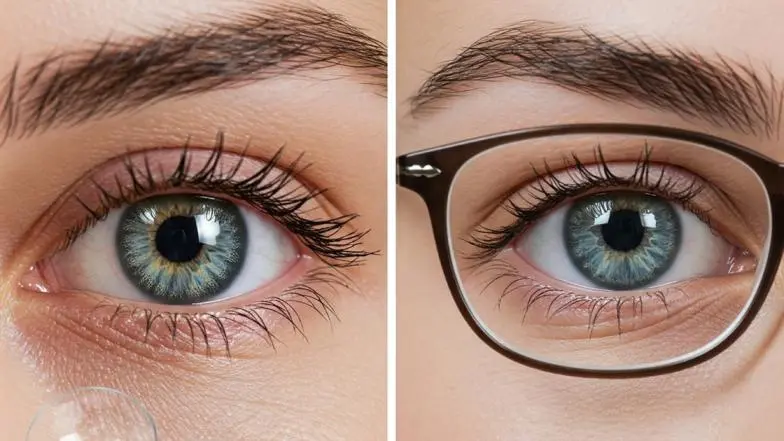Glasses vs Contact Lenses: What’s Actually Better for You?
When it comes to vision correction, many people wonder whether contact lenses or glasses are the better choice. The truth is, there’s no one-size-fits-all answer. Both options have their advantages and drawbacks, and the right choice depends on your lifestyle, preferences, and specific vision needs.
To help you decide, this article will break down the pros and cons of glasses and contact lenses in simple terms. By the end, you’ll have a clearer understanding of which option suits you best.

AUTHOR
Ophthalmologist/ Eye Surgeon 13+ Years Exp
MBBS, MS – Ophthalmology
CONDITION
CALL US 24/7 FOR ANY HELP
GET IN TOUCH ON
Understanding Your Choices
Before we get into comparing, it’s important to understand what glasses and contact lenses actually do. Both serve the same basic purpose—to correct your vision—but they work in different ways:
- Glasses rest on the bridge of your nose and correct vision by refracting (bending) light as it enters your eyes through lenses.
- Contact Lenses sit directly on the surface of your eyes (the cornea), providing a more seamless field of vision.
Now, let’s break down the benefits and limitations of each.
The Benefits of Glasses
If you’re considering glasses, here are the key advantages to keep in mind:
1. Easy to Use
Glasses are as simple as it gets. You just put them on, and they work. There’s no need to touch your eyes, and you don’t need a special routine to care for them (aside from cleaning the lenses).
2. Low Maintenance
Unlike contact lenses, glasses don’t require frequent replacement or elaborate care routines. All you need is a microfiber cloth and lens cleaner to keep them in good condition.
3. Fashionable Frames
Glasses are no longer just a medical tool; they’ve become a fashion accessory. With countless frame designs, you can find one that reflects your personality and style.
4. Safer for Your Eyes
Because glasses don’t touch your eyes, they don’t carry the risk of infections that improper handling of contact lenses can cause. Additionally, glasses act as a barrier against dust, wind, or allergens, providing some protection for your eyes.
5. Durable and Long-Lasting
A good pair of glasses can last for years if your prescription doesn’t change. This makes them an economical option for many people.
Real-Life Example:
Sneha, a college student, chose glasses because of her sensitive eyes. She found them more comfortable for long hours of studying and appreciated the stylish frames that complemented her outfits.
Limitations of Glasses
Of course, glasses aren’t perfect. Here are some challenges you might face:
- Distorted Peripheral Vision:
Glasses don’t fully cover your field of vision, so the edges of the frame may block your peripheral view. - Clunky During Physical Activities:
Glasses can slip down your nose or fall off during sports or intense movements. They might not be the most practical option for active individuals. - Fogging and Scratching:
Glasses fog up in humid conditions, like when wearing a face mask, and may get scratched if not handled carefully. - Weight on Your Face:
Some people find glasses uncomfortable, especially if they are heavy or don’t fit well.
Now, let’s turn to their counterpart, contact lenses.
The Advantages of Contact Lenses
Contact lenses have become increasingly popular for people seeking clear vision without the bulk of glasses. Here’s why:
1. Natural Vision Experience
Unlike glasses, contact lenses sit directly on your eyes, providing a more natural and seamless field of vision. They eliminate the distortion or frame obstruction that glasses can cause.
2. Freedom During Activities
Contacts are ideal for active lifestyles. Whether you’re playing sports, dancing, or simply moving around a lot, you won’t have to worry about them falling off or getting in your way.
3. Aesthetics
Contacts are nearly invisible. They don’t alter your appearance, allowing your natural face to shine through. Plus, if you want to change up your look, coloured contact lenses can give you a new eye colour.
4. Better Peripheral Vision
Since contacts move with your eyes, they correct your peripheral vision too, unlike glasses, which only improve the visual field directly in front of you.
5. Variety of Options
Contact lenses come in various forms to suit individual needs:
- Daily Disposables: Perfect for those who don’t want the hassle of cleaning lenses.
- Extended-Wear Lenses: Designed for overnight usage.
- Toric Lenses for people with astigmatism.
- Multifocal Lenses for people needing both near and far vision correction.
Real-Life Example:
Arun, an amateur football player, switched to contact lenses because his glasses kept falling off during matches. Since then, he feels more confident and free to move without restrictions.
Challenges of Contact Lenses
However, contact lenses do have their downsides:
- Maintenance and Hygiene:
Contacts require strict cleaning and storage routines. Neglecting them can lead to eye infections or irritation. - Cost:
Over time, contact lenses can be more expensive than glasses, especially if you use daily disposables. - Risk of Eye Problems:
Improper use of lenses can increase the risk of dry eyes, allergies, or infections. - Adjusting to Use:
Some people find it difficult to insert and remove contact lenses, particularly if they are squeamish about touching their eyes.
Comparing Glasses and Contacts
Here’s a quick comparison to summarise:
Feature | Glasses | Contact Lenses |
Ease of Use | Very easy | Requires practice and care |
Field of Vision | May be obstructed by frames | Full field of vision |
Cost | Economical in the long run | Higher recurring cost for maintenance |
Risk of Infection | None | Possible with poor hygiene |
Comfort During Activities | Can slip or fall during sports | Ideal for active lifestyles |
Aesthetic Appeal | Frames may not suit everyone’s style | Invisible, enhances natural appearance |
Peripheral Vision | Limited | Clear and seamless |
Can You Choose Both?
Yes! Many people opt for both glasses and contact lenses, using them based on convenience. For instance:
- Wear contacts while working out or attending a special occasion.
- Switch to glasses at home or when you want to give your eyes a break.
Having both options on hand can offer the best of both worlds. Just make sure you consult your eye doctor to ensure your vision correction needs are met properly.
⇒Case Study:
Meera, a corporate professional, wears contact lenses during office hours for a polished, professional look. However, she switches to her glasses at night to relax her eyes after a long day.
FAQs About Contact Lenses and Glasses
1. Are contact lenses better for dry eyes?
Not always. If you have a history of dry eyes, some lenses might worsen the condition. However, specific lenses made for dry eyes can help.
2. Are glasses cheaper than contact lenses?
Generally, glasses are less expensive over the long term since they don’t need frequent replacement.
3. Do I need a separate prescription for contacts?
Yes, contact lenses require a different prescription with additional measurements like base curve and diameter.
4. How often should I replace my glasses?
You only need new glasses if your prescription changes or your current pair gets damaged.
5. Is it safe to sleep in contact lenses?
Unless specified by your eye doctor, it’s not recommended to sleep in contact lenses as it increases the risk of eye infections.
Final Thoughts
The choice between glasses and contact lenses comes down to your personal preferences, lifestyle, and vision needs.
Glasses are practical, low-maintenance, and stylish, while contact lenses offer a natural look and versatility for active lifestyles.
There’s no wrong answer here, and many people find using both is the best solution.
Your eyes are as unique as you are, so take your time to explore and consult with an eye specialist to find the right fit.
Whether you choose one or both, what matters most is maintaining good eye health and seeing the world clearly!
Appointment Form
AUTHOR
Ophthalmologist/ Eye Surgeon 13+ Years Exp
MBBS, MS – Ophthalmology
CONDITION
CALL US 24/7 FOR ANY HELP
GET IN TOUCH ON
Appointment Form
About Us
Saijyothi Eye Hospital, where excellence meets compassion. Founded by the esteemed Dr. Saibaba Goud, M.S., Ph.D., Padma Shri Awardee, our institution stands as a beacon of hope for those seeking exceptional eye care. Dr. Saibaba Goud’s vision goes beyond restoring sight, aiming to transform lives. At Saijyothi Eye Hospital, we offer exceptional care, from routine eye exams to advanced surgeries, with personalized services tailored to each patient’s needs.
Our Locations:
West Marredpally
- Plot No 185, Road No 1 Beside Kennedy School, Opposite lane to Om Shanthi Foods, West Marredpally, Secunderabad-500026.
Kompally
- 3rd Floor, Vaishnavi Lemini Arcade, Doolapally Road, Above Ratnadeep Super Market, Devender Colony, Kompally, Hyderabad, Telangana 500014
Uppal
- D.No. 2-2-15, Hanuma Sai Nagar, Uppal X Roads, Near Gandhi Statue Centre, Uppal, Hyderabad, Telangana 500039

